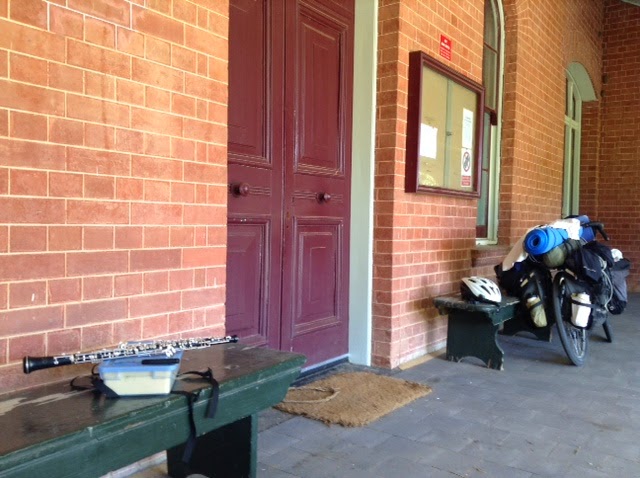I'm starting to pass through towns with significant indigenous populations. Sadly, this seems to mean more crime and vandalism. My next stop, Gulargambone, is typical. In addition to the usual closed shops resulting mainly from the depopulation of the surrounding farms, there are bars on all the windows, lots of broken glass on the ground, and other signs of vandalism. The swimming pool in Gulargambone had a nasty guard dog inside the fence.
Gulargambone was otherwise pleasant enough, with a nice caravan park and friendly people. I even met two friendly aboriginal women working in the cafe at breakfast.
 |
| The Warrumbungles |
The ride to Coonamble was short and easy, with a tailwind. The road is a sort of major highway, but traffic is light. The caravan park, however, had a major problem, as there were thorns everywhere. I found a mostly bare patch of dirt, borrowed a shovel, and cleared a spot big enough for my tent.
 |
| They want to frac here, too |
After all that work, having found a good oboe spot at the sports ground, I decided to stay another day. The next morning, I had just gotten everything set up in the grandstand, reed tools included, when the maintenance guy showed up to hose it down. At least nothing got wet this time! I went back in the afternoon, after the place had dried out.
Meanwhile, I pulled a whole bunch of small thorns out of my tires. None were large enough to cause punctures.
At Coonable, I reached the Great Artesian Basin, a huge aquifer which provides water to inland Australia. Here, it comes out of the ground at 37 C (98 F).
 |
| The Great Artesian Basin |
I was determined not to ride the 115 km to Walgett into a headwind, waiting it out, if necessary. Mother Nature, however, was having none of that. After 30 km of crosswind, it shifted into my face for most of the ride.
 |
| 100 km to Walgett |
 |
| On the Road to Walgett |
I got to Walgett an hour before sunset, but the camping options didn't look attractive.
The fortifications in Walgett are impressive. The supermarket, for example, at night retreats into a shell of concrete and steel, like a turtle. Most of the capital in town must be invested in steel bars and concrete. I retreated to a well-fortified motel. The aboriginal bartender at the restaurant where I had dinner was friendly enough.
The supermarket came out of its shell in the morning, so I could get some food for the shorter ride to Lightning Ridge, a tourist town among the opal mines. It was a barren ride, getting ever drier, but Lightning Ridge was a nice town, not nearly as heavily fortified as Walgett. The caravan park even had WiFi, and I arrived in time to call my friend in Finland. I had to evict a mob of kangaroos to put up my tent, but there were no thorns. There was even some shade and tables, so I stayed a second night.
 |
| The Lightning Ridge Turn-off |
 |
| Lightning Ridge Tent Site |
 |
| Lightning Ridge Sunset |
It was another warm day for the ride to Hebel, just across the border in Queensland. It was still very dry, and termite mounds started to appear along the road. No sign of grass, though small trees survive where they haven't been cleared. I'm told there hasn't been a real rain here tn 4 years.
Hebel consists of a pub and a store/restaurant/caravan park. The latter is run by Barb and Ralph, who have been there 10 years. The place is for sale now, as they are fixing up an old bus in anticipation of joining the ranks of "grey nomads". Meanwhile, they served a great dinner (lamb cutlets) and breakfast.
 |
| On to Hebel |
 |
| Border Crossing |
 |
| Roo Bars |
 |
| Hebel Sunset |
 |
| Hebel Pub |
 |
| Hebel Store |
About half way to Dirranbandi the next day, everything turned green. There was even standing water along the road in places. I'm told the summer was dry and that the rain just arrived. Just outside Dirranbandi, I started seeing trucks with huge rolls of cotton, as the harvest is in progress. The "volunteer" cotton plants along the road are another sign of rain, as the fields are all irrigated.
 |
| Green North of Hebel |
Dirranbandi is another dying farm town, most of the former businesses closed. A pub, grocery, and bakery remain, the latter two apparently run by recent immigrants. The caravan park had thorn-free grass, so the town met my meager needs.
The next stop, 65 km east, was Thallon, which consists of a pub/post office/tiny store, and camping at the sports ground, with horses grazing in the oval. There was a big crowd for dinner at the pub. One friendly cotton farmer bought me a beer, introduced me to 3 generations of his family, and told how his grandfather had cleared the prickly pear.
I left Thallon early the next day, in case I wanted to ride all the way to St. George, a bigger town. It was another warm day, with a strong headwind. 33 km from Thallon is the legendary Nindigully Pub. There's no pretense of a town, but there's free camping, so I decided to have a lazy afternoon, and ride on to St. George in the morning.
All this sunshine and northerly progress hasn't been compatible with oboe playing, as my lips keep getting sunburned, no matter how often I apply sunscreen. Oh well, I'll be turning east soon.



















